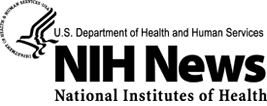Last updated: July 31, 2012
NIH ramps up Human Microbiome Project

National Human Genome Research Institute
www.genome.gov
NIH ramps up Human Microbiome Project
Funds awarded for disease demonstration studies and technology development
 Bethesda, Md., Tues., Sept. 7, 2010 — The National Institutes of Health today announced it has awarded approximately $42 million to expand the scope of eight demonstration projects designed to link changes in the human microbiome to health and disease. The funds will also support investigators to develop innovative technologies to improve the identification and characterization of microbial communities of the human microbiome.
Bethesda, Md., Tues., Sept. 7, 2010 — The National Institutes of Health today announced it has awarded approximately $42 million to expand the scope of eight demonstration projects designed to link changes in the human microbiome to health and disease. The funds will also support investigators to develop innovative technologies to improve the identification and characterization of microbial communities of the human microbiome.
The human microbiome comprises all the microorganisms that reside in or on the human body. It consists of beneficial and harmful microbes that include bacteria, viruses, fungi and other microbes.
The expanded disease demonstration projects are part of the Human Microbiome Project, a $157 million, five-year effort launched in 2008 as part of the NIH Common Fund's Roadmap for Medical Research. The project will produce a resource for researchers seeking to understand the function of the human microbiome in health and disease and to provide strategies to develop new therapies that manipulate the human microbiome to improve health.
In 2009, the project funded 15 year-long pilot disease demonstration projects that sampled the microbiomes of healthy volunteers and volunteers with specific diseases at body sites thought to have a microbiome association. The seven body sites sampled were the digestive tract, the mouth, the skin, the nose, the vagina, the blood and the male urethra. After one year, each pilot project was evaluated based on progress toward milestones and the ability of each study to demonstrate a definable relationship between a body site microbiome and a specific disease.
"Preliminary evidence from several of the project's pilot demonstration disease projects suggests that a significant relationship exists between changes in the human microbiome and human health and disease," said National Institute of Allergy and Infectious Diseases Director Anthony S. Fauci, M.D., co-chair of the Human Microbiome Project's Implementation Group. "We are providing additional support to those studies that hold the most promise for improving our understanding of how human health and disease are influenced by the human microbiome."
Scientific review of the pilot demonstration projects was conducted to determine which studies would be expanded based on several criteria, including: the potential of each study to achieve the goals of the disease demonstration program; its clinical significance; and which had the strongest scientific merit. Generally, the expansion of each study includes the additional recruitment of study volunteers, more robust sequencing analyses of the human microbiome and stronger statistical tests applied the additional samples.
The eight expanded disease demonstration projects listed by principal investigator, body site(s), disease focus and approximate first-year funding levels are:
Gregory A. Buck, Ph.D., Virginia Commonwealth University, Richmond
Vagina: Bacterial Vaginosis and Sexually Transmitted Diseases
$ 6.9 million (3 years)
This study will measure changes in the vaginal microbiome and its association with environmental factors, the presence of diseases and a woman's genetic makeup.J. Dennis Fortenberry, M.D., Indiana University-Purdue University at Indianapolis
Male urethra: Puberty, Sexual Activity and Sexually Transmitted Diseases
$4.2 million (3 years)
Samples will be collected from an ethnically diverse group of male adolescents to characterize the male urethral microbiome and its association with puberty, sexual activity and sexually transmitted disease.Zhiheng Pei, M.D., Ph.D., NYU School of Medicine
Mouth and digestive tract: Esophageal Adenocarcinoma
$5.2 million (3 years)
This team will sample the oral cavity, esophagus, and stomach to study the relationship of the microbiome from these body sites with gastric esophageal reflux disease (GERD) and with esophageal cancer.Julie Segre, Ph.D., National Human Genome Research Institute, Bethesda, Md.
Skin and nose: Atopic Dermatitis, Immunodeficiency Syndromes
$3.1 million (3 years)
The goal of this study is to examine the microbiomes of the skin and nose in patients with an inflammatory skin disease called atopic dermatitis. Researchers will look for associations between the microbiomes, genetic factors associated with atopic dermatitis, and with immunodeficiency syndromes.Phillip I. Tarr, M.D., Washington University School of Medicine, St. Louis
Digestive tract: Neonatal Necrotizing Enterocolitis
$5.2 million (3 years)
This group of researchers will examine the potential connection between the intestinal microbiome and the development of neonatal necrotizing enterocolitis, a gastrointestinal disorder in premature infants, in which portions of the bowel undergo tissue death.James Versalovic, M.D., Ph.D., Baylor College of Medicine, Houston
Digestive tract: Pediatric Irritable Bowel Syndrome (IBS)
$3.4 million (3 years)
This project will examine the composition of the intestinal microbiome and possible connections with irritable bowel syndrome in children.Gary D. Wu, M.D., University of Pennsylvania School of Medicine, Philadelphia
Digestive tract: Crohn's Disease
$1.1 million (1 year)
In children, Crohn's disease, a form of inflammatory bowel disease, is clinically treated through diet. This team will investigate whether these specialized diet regimes work by altering the composition of the intestinal microbiome. Partial funding for this project will be provided by NIH's Office of Dietary Supplements.Vincent B. Young, M.D., Ph.D., University of Michigan, Ann Arbor
Digestive tract: Ulcerative Colitis
$8.2 million (3 years)
Some patients who suffer from ulcerative colitis, a type of inflammatory bowel disease that causes inflammation and sores in the lining of the rectum and colon, are treated with surgical removal of the colon, followed by construction of a pouch to assist the patient with bowel movements. For unknown reasons, some patients develop inflammation of the pouch, necessitating further surgery. This research will determine whether the composition of the pouch microbiome influences the onset and progression of pouch inflammation.
Historically, microbes have been studied in the laboratory as cultures of isolated species. Microbial growth is dependent upon a very specific natural environment, and it is often difficult to duplicate these conditions in a laboratory. Therefore, the development of novel and innovative technologies is needed to improve and refine the identification and characterization of the microbes that comprise the complex mixtures found in and on our bodies.
The principal investigators who will develop new technologies, their approximate funding levels and their areas of research are:
Emma Allen-Vercoe, Ph.D., University of Guelph, Ontario
$179,000 (2 years)
A Method to Sort and Enrich the as-yet Uncultured Bacterial Species from the Human Distal GutRonald Davis, Ph.D., Stanford University, Palo Alto, Calif.
$440,000 (2 years)
Isolation, Selection and Polony Amplification of Single Cells in a Gel MatrixDavid Fredricks, M.D., Fred Hutchinson Cancer Research Center, Seattle
$2 million (3 years)
Novel Cultivation Methods for the Domestication of Vaginal BacteriaRustem Ismagilov, Ph.D., University of Chicago
$1.1 million (3 years)
Confining Single Cells to Enhance and Target Cultivation of Human MicrobiomeKim Lewis, Ph.D., Northeastern University, Boston
$1.2 million (3 years)
Culturing Uncultivatable Gut MicroorganismsJohn Nelson, Ph.D., General Electric Global Research, Niskayuna, N.Y.
$538,000 (2 years)
Tools for Human Microbiome Studies
Analysis of the sequence data from the Human Microbiome Project also requires the development of new and novel computational approaches to study the associations of the microbiome with specific body sites and with specific diseases. Anticipated in fiscal year 2010, the Human Microbiome Project's computational tools program will award additional funds to produce bioinformatic tools for the research community to analyze microbiome diversity and to evaluate the human microbiome and disease progression.
More information about the Human Microbiome Project is available at www.nihroadmap.nih.gov/hmp/ and www.hmpdacc.org.
An illustration showing the body sites that will be sampled as part of the Human Microbiome Project is available at: http://www.genome.gov/dmd/img.cfm?node=Photos/Graphics&id=85347.
A high resolution image of the bacteria, Entercoccus faecalis, a microbe that lives in the human gut, is available in color at www.genome.gov/dmd/img.cfm?node=Photos/Microorganisms&id=79092, or in black and white at www.genome.gov/dmd/img.cfm?node=Photos/Microorganisms&id=79093.
The Human Microbiome Project is funded through the Common Fund, and managed by the NIH Office of the Director in partnership with the National Institute of Allergy and Infectious Diseases, National Institute of Arthritis and Musculoskeletal and Skin Diseases, National Cancer Institute, National Institute of Dental and Craniofacial Research, National Institute of Diabetes and Digestive and Kidney Diseases and National Human Genome Research Institute, all part of NIH. The NIH Common Fund encourages collaboration and supports a series of exceptionally high impact, trans-NIH programs. Common Fund programs are designed to pursue major opportunities and gaps in biomedical research that no single NIH Institute could tackle alone, but that the agency as a whole can address to make the biggest impact possible on the progress of medical research. Additional information about the NIH Common Fund can be found at http://commonfund.nih.gov.
The National Institutes of Health (NIH) -"The Nation's Medical Research Agency" - includes 27 Institutes and Centers and is a component of the U. S. Department of Health and Human Services. It is the primary federal agency for conducting and supporting basic, clinical and translational medical research, and it investigates the causes, treatments and cures for both common and rare diseases. For more information about NIH and its programs, visit www.nih.gov.
Contact
Geoff Spencer, NHGRI
(301) 402-0911
spencerg@mail.nih.gov
Additional Contacts
NIH Office of Communications
(301) 496-4461
NIAID News Office
(301) 402-1663
niaidnews@niaid.nih.gov
Trish Reynolds, NIAMS
(301) 496-8190
Reynoldsp2@mail.nih.gov
Bob Kuska, NIDCR
(301) 594-7560
kuskar@nidcr.nih.gov
Leslie Curtis, NIDDK
(301) 496-3583
niddkmedia@mail.nih.gov
